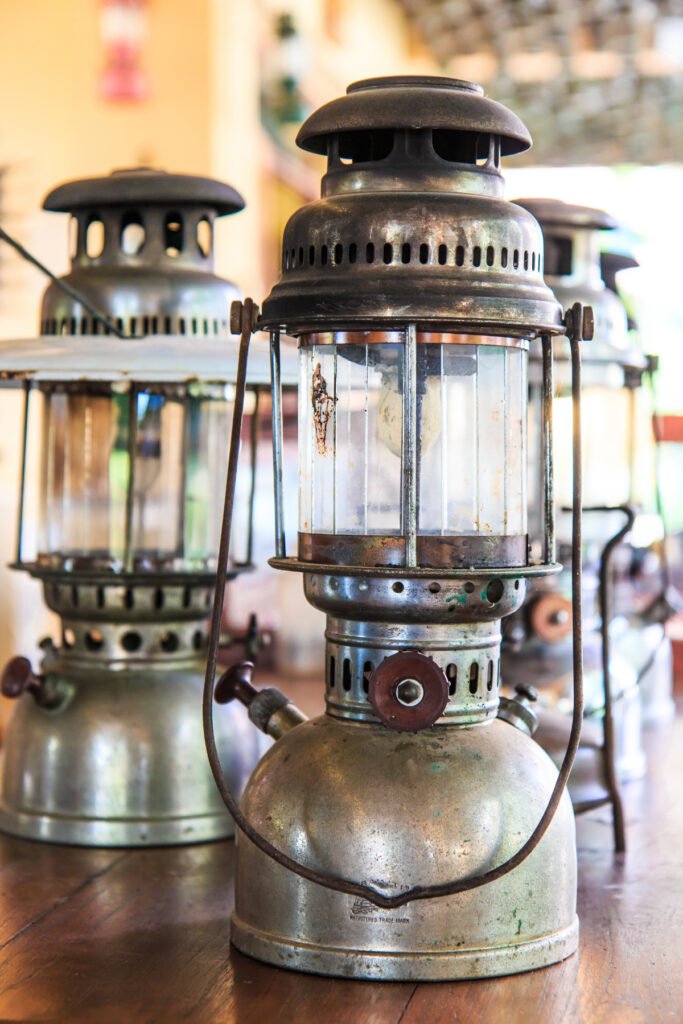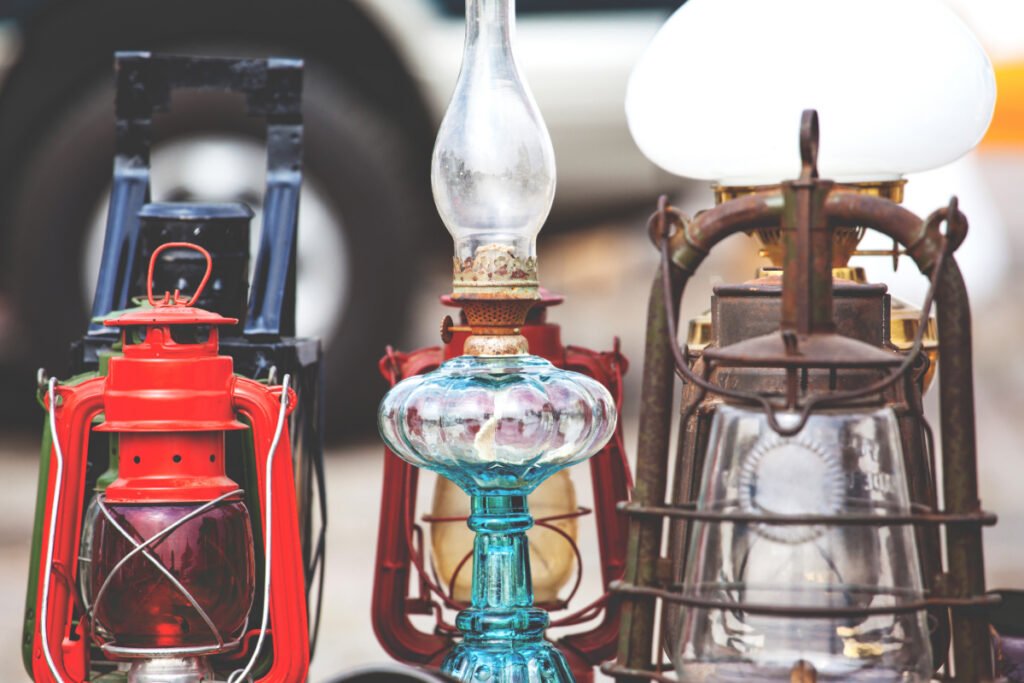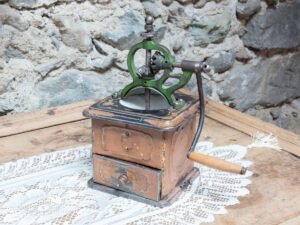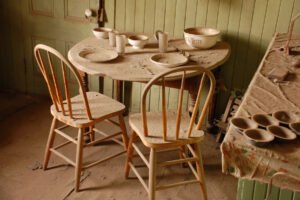If you found an old, rusty working oil lamp in your basement, you are in luck! How you may ask! Well, oil lamps have their origin traced back to the 17th century. And ancient items always get the attention of antique lovers.
There are chances that the lamp you have set up on your table is worth more than you think. This detailed guide will help you identify and price antique oil lamps for a good resale. Shall we begin?
Key Takeaways
- Check if your oil lamp has mouth-blown edges, stick-thin stems, wicks, and threaded shafts to pick the old and authentic ones.
- Get brushed metal, tin, or brass lamps for the best returns. But if you want a warm finish, copper or bronze lamps are best!
- You have four types of valuable oil lamps – Cruise, Betty, Central Draught, and Banquet. Of these, the Banquet ones are the most precious, while the rest are affordable.
- Tubed or hanging burners are new and cheaper. So, pick the typical holed lamps and air wicks for an old make.
How to Identify Vintage Lamps?

What do you imagine when you hear about an antique oil lamp? If you see an old, rusty lamp with handles, motifs, and some carvings, you’re almost there!
But old oil lamps also have thin handles and wicks that speak of their age. You could also find some stickers or handmade collars with glass-blown marks.
But what else differentiates old antique lamps from regular ones?
- Geometric or etched glass patterns with authentic, hand-painted designs
- Crystal lamp stems, burners, and wick holders with smaller finger loops
- Mouth-blown glass surfaces and transparent or amber-colored sidings
- Forked or crown-shaped burners with long tubes and brass plates
- Partial or fully threaded frames and a smoother, central oil shaft
- Surface decoration and bulbous glass or metal lobes at the bottom
History & Evolution of Oil Lamps
Tracing it all back, the Greeks made the first oil lamps in the 16th Century AD. With limited sources, these earthen or stone lamps were hand-molded. They had thicker walls, funnel-shaped tubes, and jade or teak wood caps with natural beeswax or olive oil wicks.
Then came the commercial lanterns of the 1700s. You can identify them with their tin walls, cylindrical shape with wider bases, and central oil tubes. Some also have floral motifs and meshes that raise their price.
The later 18th-century lamps were minimal. They had cast designs, stems, and finished plaster joints and seams. These lamps were highly thin and portable.
And the best part? Such branded, factory-made oil lamps are extremely precious today!
4 Types of Antique Oil Lamps & Their Value
Tracing from the 17th century to the present, there are many types of vintage oil lamps with different shapes, patterns, and mechanisms that affect their worth. Let’s look at these types!
1. Cruise Lamp (1700s)
If you see an old, handmade lamp with beak-shaped pulleys, finger loops, and sloped wicks, it’s a cruise oil lamp! These are very functional and have two oil lamps and sloped wicks, costing $200 – 250.
2. Betty Lamp (1800s)

These are small, tear-shaped lamps with thick walls, shallow bases, and sharp wicks. They don’t have any caps, but you can find bear handles and chains, costing $270 – 300.
Betty lamps also have three types based on their anchors:
- Whale Oil Hanging: These Betty lamps are screw-fit with curved rings to hang them. They have thicker handles, baseplates, and a rough brass finish that costs $270.
- Pointed Pin Betty: These lamps have threaded screws and wall plates. So, they’re pretty easy to fix. They also have a shorter stem and oil tube, costing $280 – 290.
- Chainlink Wick Pick: These are square-base chain lamps with multiple wick holders. They have thick cast-iron walls raising their valuation to $300.
3. Central Draught Lamp (1800s)

If you notice thick glass, a central air shaft, and bulbous shape with your lamp, it’s a central draught one. Such lamps also have extra holes, floor stands, and iron chains to release heat. Plus, you’ll also see control pulleys, wires, and oil tubes, costing $140 – 150.
4. Banquet Oil Lamps (1900s)

Banquet oil lamps are painted or decoupage glass lamps with shiny metal lobes. Branded by Miller or Fostoria, they might fetch up to $12,000 with their local designs or WWI motifs.
8 Factors to Spot a Vintage Oil Lamp & Assess Its Worth
Old oil lamps are worth $500 – 600 if they have natural carvings, brass finishes, and minimal physical damage throughout the years. Similarly, the lamp will fetch good returns with stiff, flat handles and grayish surfaces. Naturally, the final worth of vintage oil lamps depends on their age, colors, materials, and a few other crucial factors listed below!
1. Oil Lamp’s Age

We all love old pieces for their handmade finish, right? So, if you want carved and intricate pieces, get the 1700s ones. And, if you want some colored or high-burning pieces, then the 1800s models are perfect. Get them with dropped wicks and short pipes for the best returns!
But if you want minimal, high-polish lamps, the 1900s models are perfect! They are just machine-made and cheaper.
Now you’re probably wondering how you would know your lamp’s age. Well, we’ll help you track it easily.
1. Lamps from the Early 1700s: These lamps are easily identified by their thick tin or brass walls. They’re about 6 – 10 inches tall and have chain links or flat handles for hanging. Dropped wicks and oil tanks raise the cost to $800.
2. Lamps from the 1800s: These lamps have transparent, brass or red glass walls with metal stems and wicks. These are more useful for decorations than light and come with short pipes and wicks. These lamps cost around $100 – 600.
3. Lamps from the 1900s: These steel lanterns are cylindrical and have sharp wicks and bulbous heads. They are mountable on walls. But, they have a low demand and valuation of $80 – 100.
Here are some common patent numbers for easy reference:
| Year | Lamp Age | Patent Number | Manufacturer | Valuation |
| 1862 | 160 years | 35158 | John H. Irwin | $400 – 500 |
| 1902 | 120 years | 706,7l7 | Figli | $1000 – 1200 |
| 1890 | 132 years | US439672A | J. A. Miller | $500 – 600 |
Pick lamps with hammered, satin, or textured finishes for an old make.
2. Oil Lamp Shape

Oh, yes! An oil lamp’s shape can tell a lot about its worth. Like, if it has a pointed, bulbous, or natural shape, it’s old and precious. If it looks planar and cuboidal, it’s mass-produced and cheaper. And if it looks like a lotus or flower, it might be branded and in demand.
| Shape of the Lamp | Average Valuation |
| Tubular, Cylindrical, or Barrel | $1000 – 1500 |
| Elephant, Lion, or Animal-shaped | $1000 – 1200 |
| Bellflower or Lotus | $800 – 900 |
| Pigeon, Parrot or Sparrow-shaped | $400 – 500 |
| Half Moon or Crescent | $400 – 450 |
| Pendant or Tear-shaped | $150 – 200 |
| Square, Rectangular or Circular | $40 – 100 |
3. Oil Lantern Color

Old oil lamps are usually gray or bare metal. But that’s not always the case! If you see their seams, they might be yellow, copper, red, or green! In fact, all these are limited-edition colors and fetch a good price!
However, things might go wrong with the 18th-century oil lamps. I mean, look at their machine polishes and brown paint! Those don’t attract much and are cheaper!
Want to know how each color affects an old oil lamp’s value? Check the table below!
| Oil Lamp Color | Manufacturing Year | Age | Valuation |
| Gray, Black, or Brushed Metal | 1700 | 322 years | $300 – 450 |
| Yellow, Amber, or Copper | 1750 | 272 years | $100 – 120 |
| Emerald Green or Blue | 1800 | 222 years | $60 – 70 |
| Red, Olive, or Orange | 1860 | 162 years | $30 – 45 |
| Brown or Galvanized | 1950s | 72 years | $12 – 15 |
Rusty galvanized finishes might look brushed and antique. So, rub your finger onto the lamps edge, and check for a powdery finish.
4. Antique Oil Lamps Brands

Branded things are always worth it, aren’t they? Well, antique oil lamps are no exception.
So, if you see thick-walled, fancy lamps, you are about to make a fortune! Here, you can also pick gold inlay or patchwork pieces to raise the cost by 5 – 6%.
Also, don’t forget to check the lamp’s sides, seams, or bases for more marks and tax invoices. Why leave a chance to make your lamp worth more?
Check out these vintage oil lamp brands for better returns and valuation:
| Lamp Name | Manufacturer | Year | Valuation |
| Dragonfly Lamp | Tiffany & co | 1991 | $5000 – 6000 |
| Cranberry Rayo Rochester | Aladdin | 1950s | $500 – 650 |
| Lily Lamp | Tiffany & co | 1990 | $40,000 – 50,0000 |
| Victorian Banquet Oil Lamp | Rochester | 1990s | $300 – 350 |
| Art Nouveau Victorian Kerosene Oil Lamp | Rochester | 1910s | $12,000 – 12,500 |
5. Rarity

Here’s the deal, the rarer the lamp, the more valuable it is.
Unique angel or animal-shaped lamps with rare colors and glass sidings are precious, no matter how old it is and what condition it is in. Apart from unique designs, they can have gem-studded surfaces or gold leaves too!
It’d be even more beneficial if they have leftover oil stains or used wicks (don’t wash your old lamps). These natural things hike the costs.
Here are some rare oil lamps for high valuation and returns:
| Lamp Name | Manufacturer | Year | Shape | Auction Site | Valuation |
| Dragonfly Oil Lamp | Tiffany | 1880s | Pembroke | Etsy | $11,869 |
| Ormolu Oil Lamp | Longwy | 1850 | Bulb or Spherical | Mayfair Gallery | $6700 |
| Meissen Porcelain Oil Lamp | Dresden | 1880 | Connected Spiral | eBay | $5150 |
| Miners Lamp | Pruss | 1800 | Lock-shaped | Etsy | $4500 – 5000 |
| Boston Sandwich Oil Lamp | Sinumbra | 1850 | Bulb | eBay | $4250 |
6. Lamp & Anchoring Style

Antique lamps have different anchoring styles! So, if you see thick handles and finger loops, you have a rare oil lamp. If you get it with chains or inbuilt grooves, it’s an 1860s lamp. And if you notice the welded plates and reflectors, it’s a cheap 1900s lamp.
And here’s how all these hanging styles impact an antique oil lamp’s value.
| Anchoring Style | Average Valuation |
| Curved Handles or Levers | $200 – 220 |
| Finger loops or Spikes | $150 – 200 |
| Chains or Hangers | $150 – 170 |
| Table-rest or Large base | $30 – 60 |
| Wall attached or Glued | $15 – 25 |
Select partial or fully threaded-oil lamps for higher pricing. Check for polished brass threads or copper seams to increase the cost.
7. Burner Style
Believe it or not, the burner style can affect the value of your antique lamp. Vintage oil lamps with typical prongs, crowns, or holed burners cost more than $200.
In contrast, tube or burning fluid burners are factory-made and economical. But, center stack burners from the WWI era are in-demand and fetch high returns at an auction.
8. Production Markings
Old oil lamps had embossed trademarks, block-lettered brand names, and a full circle on the rim. These marks make the lamps precious.
On the contrary, medieval lanterns had animal, sheep, or bird imprints on the handles. But, the later, factory-made lamps were simply polished and had a label at the front.
Never wash or rinse your lamps as you might rub off the oil stains or marks and devalue your lamp.
What Age Is an Oil Lamp Antique?
Generally, lamps over 90 – 100 years of age are considered antique and high-valued. So, lamps from the 1700s to the mid-1920s are precious.
Where to Sell Antique Oil Lamps?
You can sell your antique oil lamps on e-auction websites like eBay, Etsy, Antiques Atlas, and Wayfair. Or you can photograph your item properly and put it up for a bid at any local auction.
Old, handmade oil lamps are one of the most valuable and rarest antique lamps to collect! You can look for abstract, naturally-dyed lanterns for a higher valuation. Or, check the logos and brands to track their age and worth.
Vintage oil lamps are great colonial decor tools and design a well-lit corner for any house. But you can also pick a vintage wood stove if you need more light and heat in your kitchen. Explore my next detailed guide on ‘Antique wood stoves’ now!
Note: This article is intended for informational, educational, and entertainment purposes only. Some images are illustrative and may not represent actual brands, products, or related entities. All trademarks, product names, brand logos, packaging, and other intellectual property referenced remain the exclusive property of their respective owners. Any brand mentions or references are provided solely for descriptive and educational context and do not imply any formal or commercial association.









